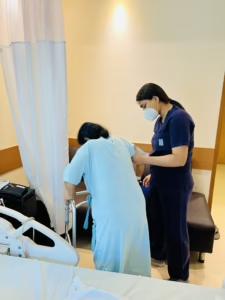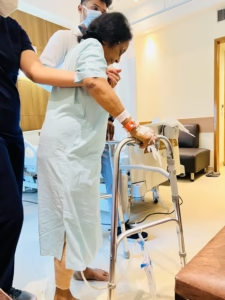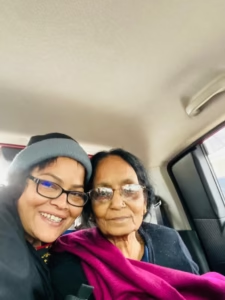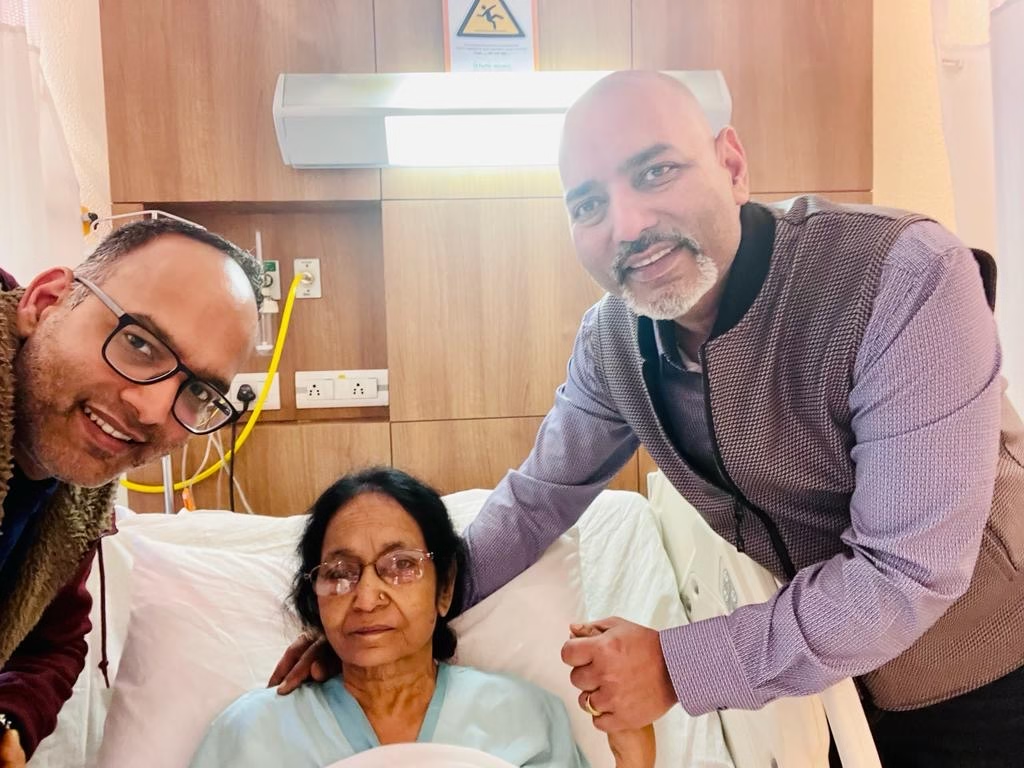My Mom’s Painful Decline
Five years ago, my mom’s life had become incredibly difficult. She couldn’t walk a step without pain—often sharp pain—in both knees. We consulted doctors in the U.S. and India, got all kinds of tests and x-rays done.
I’m not a medical expert, so here’s my simple diagnosis: her knees were a complete mess.
Her bone density was terrible—her bones had become porous like that sponge they keep in showers to scrub heels. Her kneecaps had worn out after years of wear and tear. Her knees were bone-on-bone, colliding like sharp knives. Her legs had taken a bow shape. And while this wasn’t an overnight development, the last four or five years were sheer torture.
It’s sad—and frankly embarrassing—that we waited this long to get her the care she deserved. But at the time, our family was consumed with our father’s extreme health crisis. No one had bandwidth—emotionally, mentally, or physically—to deal with anything else. That’s another blog for another day.
What Doesn’t Work At All
Between me and my younger brother Saket (the smart one, based in Sydney), we figured out very quickly what doesn’t work when the knees are truly gone:
Things that don’t work:
1. Exercise or walking – makes it worse
2. Alternative treatments – Ayurveda, Homeopathy, miracle foods. A complete waste of time and money.
3. Religious advice from the gurus and babas on TV
4. WhatsApp experts
5. Thinking you’re a good person and God will take care of your knee without you getting a knee replacement
What works temporarily (but not a good idea for long term):
– Painkillers
– Ointments
– Reducing activity to avoid pain (leads to worse muscle loss)
What Actually Works
Knee Replacement.
What Actually Works REALLY Great
A knee replacement done right, followed by disciplined physiotherapy and walking for six months.


Our Family’s Challenge
My brother Saket and I were on the opposite sides of the globe. We were also still recovering from our dad’s extended medical struggles and eventually him passing. Emotionally and logistically, we needed a one-shot, no-drama solution. No back-and-forth, no multiple surgeries. Just get it done—and get it done right.
But our mom also had heart problems—artery blockages—and was on heart medication. Most Indian doctors advised against operating on both knees at once in such cases due to blood loss and heart risk. They literally told us it could be fatal.
The Turning Point: Dr. Subhash Jangid
Saket continued his research. He found Dr. Subhash Jangid at Fortis Memorial Research Institute, Gurugram (Delhi NCR). Great reviews, modern facility, and a reputation for robotic knee replacements.
We got an appointment. After a thorough review of her knees and heart condition, Dr. Jangid said:
“We’ll do robotic, computer-navigated surgery on both knees at once. Blood loss will be minimal. Her heart will be fine.”
That was the moment of hope we desperately needed.
Traditional Knee Replacement vs. Robotic Knee Replacement
| Feature | Traditional Knee Replacement | Robotic Knee Replacement |
|---|---|---|
| Precision | Depends entirely on the surgeon’s eye and experience | Uses 3D mapping and robotic tools to guide every move |
| Fit of the Implant | General sizing and alignment | Customized to your exact bone structure for a better fit |
| Tissue Handling | May involve more cutting or adjusting during surgery | Minimizes unnecessary cutting—only what’s needed is touched |
| Blood Loss | More cutting can mean more bleeding | Minimal blood loss due to precise, controlled movements |
| Impact on Heart Patients | Higher blood loss and longer surgery can be risky | Lower blood loss is safer for those with heart or circulation issues |
| Scarring & Recovery | Larger incisions, more trauma to the body | Smaller incisions, less trauma, faster recovery |
| Surgical Accuracy | Can vary from case to case | Extremely consistent and repeatable accuracy with robotic help |
| Longevity of Results | Good, but can wear unevenly if not aligned perfectly | Better alignment means the joint lasts longer and works more naturally |
Why Robotic Is Often the Better Choice
-
Minimal blood loss is one of the biggest advantages, especially for patients with heart disease or other conditions where blood loss is a concern.
-
Fewer complications, less pain, and quicker return to walking and normal life.
-
Better long-term performance—when the implant is placed perfectly, it works better and lasts longer.
Think of it this way:
Traditional surgery is like painting freehand. Robotic surgery is like using stencils and guides—you get cleaner lines, fewer mistakes, and a much smoother result.
The Timeline of the Surgery and Recovery
Day 1: Arrived in Delhi, pre-surgery tests
Day 3: Surgery day (both knees) – Surgery took five hours total for both knees combined
Day 4: Mom walked 10–15 feet with a walker
Day 5: More walking
Day 6: Discharged from hospital
Week 2: Stitch removal
Recovery Timeline:
Walked with a walker – starting the 3rd day after surgery
Walked with a stick and no walker – after ten days of surgery
Walked without any support at all – after two weeks
Fully recovered and back in daily lifestyle of house chores, going to temple, shopping etc – after three to four weeks of surgery.
How long should one do physiotherapy after knee replacement surgery?
The Doctor advised 30-45 minutes everyday for 90 days after the surgery. Since we had in-house physiotherapy person (a physiotherapist/nursing student lives on our property in Patna, India), mom continued physiotherapy for six months.
Walking
In addition to the 30-45 minutes of daily physiotherapy, she walked a minimum of two kilometers everyday in a nearby park. She started this after three weeks of surgery and made it her lifetime routine afterwards.
Any discomfort in knees or negative impact on the lifestyle after knee replacement – NONE.
Team Effort
The entire process, if you are fully willing to stay in India for a satisfying sense of stable support to the patient, is three to four weeks. Meaning- scheduling the surgery, getting it done, and helping through the post-surgery things- stitch removal, initial physiotherapy, etc. There is nothing more to do in the etc. part though.
My brother Saket flew to India from Sydney, Australia early and handled all the pre-surgery prep. I joined with my lovely wife Mona on the surgery day, and we managed everything after—post-op care, stitches, home physiotherapy, and of course I made the social media posts.
Where Did We Stay?
Though we have wonderful friends and relatives all over Delhi, we stayed near the hospital in an Airbnb.
Quiet, clean, and gave us a private kitchen to cook our meals. Homemade food was cheaper, healthier, and emotionally comforting. Plus, we like multiple rounds of chai. If you stay at a hotel, even slightly fancy, you may have to sell a kidney just to pay for chai nowadays. So freaking expensive for no reason.
To get an idea of what Airbnb looks like and costs, you can click below- this is near Fortis in Gurgaon/Gurugram. I can’t keep up with these name changes of the cities in India. https://www.airbnb.com/gurugram-india/stays
The Cost
Surgery cost for both knees: ₹6,00,000 (about $7,000 USD in 2022)
All-inclusive budget today: ~$10,000 USD
One knee? Slightly more than half that cost
Physiotherapy after surgery in Delhi was approximately ₹1,000 ($12USD) per day.
All above is the cost without using any insurance.
Prices may have changed, so please check current rates.
Was It a Success?
100%.
My mom walks perfectly. She’s active like a teenager. We went on a long walk in Frisco recently and just when I was ready to wrap up, she said:
“Let’s do another half a mile.”
Maybe she wanted to rant about her daughters-in-law on the walk, but nothing came out. Just kidding.
She climbs stairs, handles slopes, and has zero pain. Best of all, she stands and walks with confidence. That matches her personality again—graceful and strong.
But, someone is telling you the knee replacement failed for someone they know?
Ask-
- Did they get a robotic, computer-navigated surgery? The results are different for sure.
- Did the patient follow all the post-surgery instructions properly?
- Was physiotherapy done religiously?
- Did the patient walk regularly after the surgery?
- Was the patient really overweight? (I don’t know how will you ask this but it matters.)
Surgery results will vary negatively mostly due to patient’s own lack of efforts. The robotic surgeries are templated and precise. The surgery itself going bad – I don’t see it. They are routine things like oil change for cars at these big medical institutions. Not much can go wrong if a robotic surgery is done.
There is always risk in anything you do, all you can really do is pick the best options and get things done.
The Keys to a Successful Knee Surgery
- A robotic, computer-navigated knee replacement
- A skilled surgeon like Dr. Subhash Jangid. It doesn’t have to be him. Anybody reputable like him and like a reputable facility like Fortis.
- A reputable hospital like Fortis or Max. They have branches in all big cities.
- Strict post-op care:
– Do physiotherapy religiously
– Walk regularly - No skipping or shortcuts or excuses
You can hire someone to help your parent them to the park.
You can’t hire someone to walk on their behalf. If they don’t put effort, things can fail.
Do I Know Dr. Jangid Personally?
Nope. And I am sure he has no clue who am I.
I had to dig through old emails during mom’s surgery today just to make sure I spelled his name right. He wouldn’t even remember me if he sees this blog. He may remember my brother Saket because he writes these fancy corporate-style emails. But if this blog ever reaches the doc—Dr. Jangid, you owe me a taco or something for spreading the word.
Want to Reach Him?
Dr. Subhash Jangid
Director, Bone & Joint Institute
Fortis Memorial Research Institute, Gurgaon
https://www.fortishealthcare.com/doctors/dr-subhash-jangid-2853
📧 subhash.jangid@fortishealthcare.com
📞 Appointments: +91-9999245242
🌐 www.onejointforlife.com
Why I’m Writing This
I’m writing this blog for my friends and family in India and abroad—anyone with roots in India or no roots in India but willing to travel—who may be struggling to make the right decision for their own or a parent’s knee surgery. What I am sharing isn’t a medical advice. It’s real-life experience.
Final Word
If you or anyone you know is struggling, don’t wait. Don’t ignore.
We saw our mom go from nearly immobile to energetic and pain-free. You can too.
Feel free to comment below if this helped you—or reach out with questions. I’m happy to help.
Also, please share this article on your Facebook, WhatsApp, neighborhood text groups. You never know who needs help. Don’t be shy about sharing. That is the least you can do.
For future helpful posts like this, follow me on Facebook. All my social media links are here: About KB

Hindu Funerals
Krishna Bhaskar Dealing with a Sudden Death – A Hindu Family’s Guide in the USA I have seen many Hindu families dealing with the unexpected,

This is such an inspiring read! It’s amazing how Robotic Total Knee Replacement Surgery in Tamilnadu is transforming lives and helping patients regain mobility so quickly. The precision and faster recovery time offered by robotic technology truly make a difference. Thank you for sharing this detailed guide — it gives hope and clarity to so many families considering knee replacement surgery in India.
Thank you. Good things must be shared.